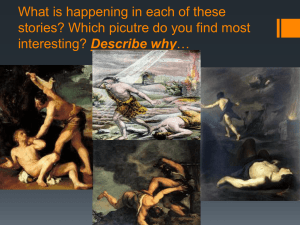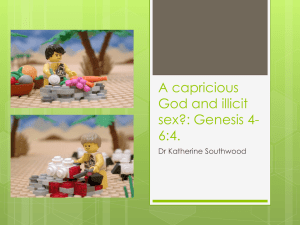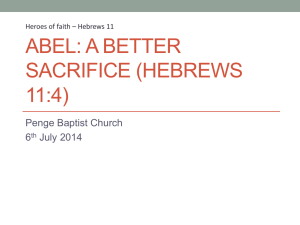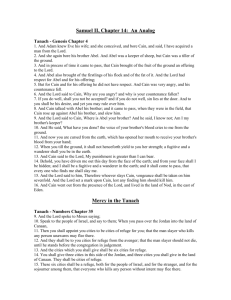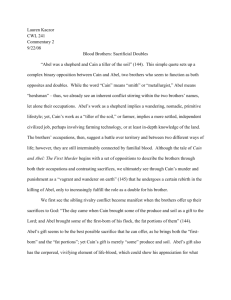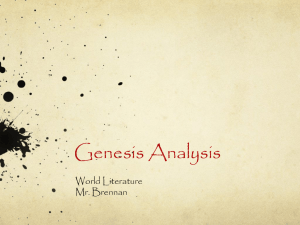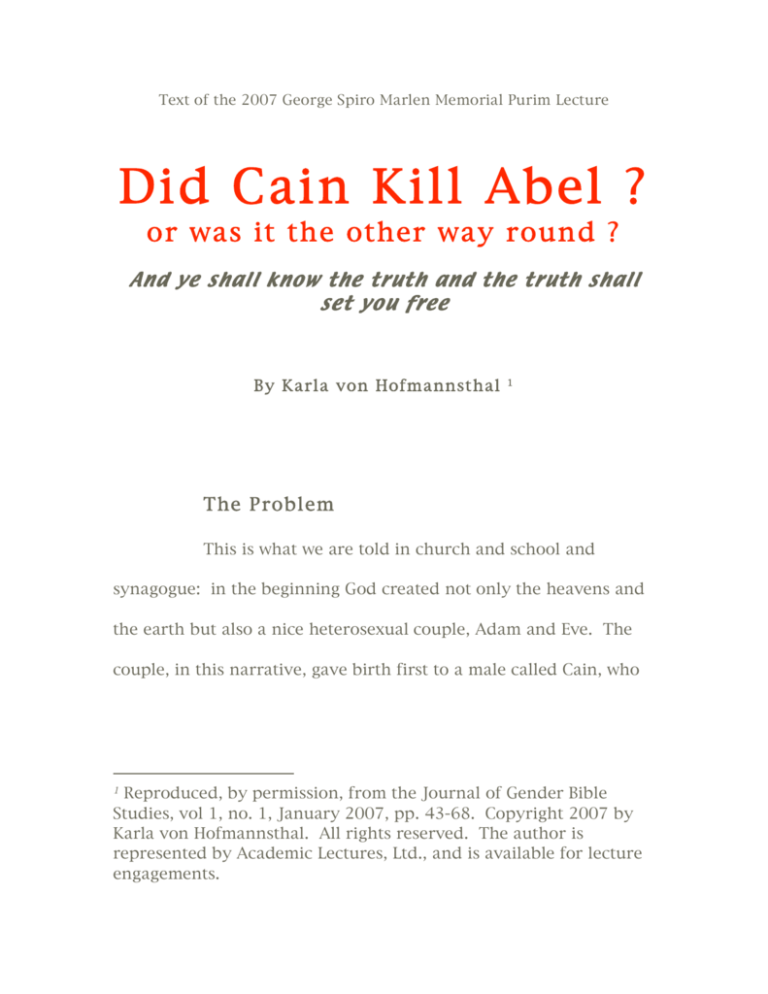
Text of the 2007 George Spiro Marlen Memorial Purim Lecture
Did Cain Kill Abel ?
or was it the other way round ?
And ye shall know the tr uth and the tr uth shall
set yo u free
By Karla von Hofmannsthal
1
The P roblem
This is what we are told in church and school and
synagogue: in the beginning God created not only the heavens and
the earth but also a nice heterosexual couple, Adam and Eve. The
couple, in this narrative, gave birth first to a male called Cain, who
Reproduced, by permission, from the Journal of Gender Bible
Studies, vol 1, no. 1, January 2007, pp. 43-68. Copyright 2007 by
Karla von Hofmannsthal. All rights reserved. The author is
represented by Academic Lectures, Ltd., and is available for lecture
engagements.
1
became a farmer, and then to Abel, who became a “shepherd.”
2
We
are then told that the farmer Cain killed the shepherd Abel, an
entirely unprovoked crime in this narrative, and that this crime was
the first murder known to man or God.
We are now in the twenty-first century, and nobody alive
can claim to have been an eyewitness to these alleged events. But
we do know more than a little what the authentic voices of the past
can teach us. To reach at the truth, we have to go beyond the
conventional twaddle of priest, rabbi, and theologian.
In this article we shall hear a more authentic narrative,
one that has passed down to us in the oral and written literature of
oppressed peoples of Europe and peoples of color everywhere. This
oft-forbidden, hidden, persecuted but very robust tale tells us that
a) it was in fact Abel who killed Cain, b) the brothers Cain and Abel
had two mothers, Lilith
3
and Eve, and c) the idea of a male “Adam”
The Douai and other Catholic versions, the King James and other
dominant Protestant versions, and the Jewish Masoretic texts all tell
essentially the same tale in the first four chapters of Genesis.
2
Concerning the authenticity of Lilith as the second mother of Abel
and Cain, see, inter alia, Raphael Patai, Adam ve-Adama, tr. as Man
and Earth; Jerusalem: The Hebrew Press Association, 1941-1942, pp.
19, ff.
3
as a parent of these brothers is a fabrication of the homophobic,
patriarchal officialdom of Western religion. This article can deal
with no more than the first part of this liberation narrative, the
killing of Cain by Abel.
The Liberation tradition
Among those resisting the manufactured consent 4 to the
Cain-Abel fraud, the name of Charles Baudelaire (1821-1867) ranks
high indeed:
Race d'Abel, voici ta honte:
Le fer est vaincu par l'épieu!
5
Of course Baudelaire was also the first modern writer to
celebrate lesbian love.
6
No wonder he is so despised by the self-
appointed guardians of conventional morality ! 7
Cf. Mark Achbar, ed., Manufacturing Consent. Noam Chomsky and
the Media, Montreal, Black Rose Books, 1994.
4
5
Charles Baudelaire, Abel et Caïn, Fleurs du Mal, Paris, 1857
6
Charles Baudelaire, Les Lesbiennes, Paris, 1845
Rosemary Lloyd, Baudelaire’s World, Ithaca, 2002, pp. 73, 97, 122,
et passim.
7
A deeper consideration of the life and work of Baudelaire
gives us a clue to why he, alone among his contemporaries in the
French literary canon, could grasp the true meaning of the age-old
folk wisdom that has been turned upside down in the conventional
version of Genesis.
Baudelaire was, before being a Frenchman (he was that
too, of course) a man of color. Born in Haiti, deeply immersed in
the tradition of Jean Jacques Dessalines (1758-1806) and Toussaint
L’Ouverture (1743-1803), he married his comrade Jeanne Duval (?1862) in Jacmel (Haiti) in about 1840. Together they devoted a
lifetime of study into the false and the true in biblical transmission.
Their independent discovery -- although of course they were not the
first – that it was Abel who killed Cain, and that the parents were the
lesbian couple Lilith and Eve, constituted an intellectual
achievement of the very highest order.
8
Many of the biographers of Baudelaire try to equivocate on these
points. But see the work of Lloyd, op. cit., and especially the book
by Jean-Paul Sarte, Baudelaire, Paris, 1946. See also Fred
Stockholder, “Mirrors and Narcissism,” Theory Culture Society, vol.
4, 1987, pp. 107-123.
8
But the Baudelaires were very exceptional. In the
sections to follow, we will have little opportunity to refer to writers
in the conventional canon; generally speaking, these gentlemen
(how rare it is to find women in this group!) always knew on which
side their bread is buttered. It is a knowledge that is obviously
indispensable for canonic status. To get at more truthful narratives,
we will have to search those anonymous sources through which the
wisdom of the oppressed of all ages has been preserved: folk tales
and folk lore, the scriptures of Third World peoples, and, last but
not least, the collective unconscious as revealed to us in the work of
Carl Jung and the analytical psychologists.
9
“Shepherd” and “Farme r”
(a) Abel
Bible translations that are promoted by Western
religious establishments portray Abel as a “shepherd” (or similar
expressions, like “keeper of sheep,” etc.). The Hebrew of the
Jolande Jacobi, The Psychology of C. G. Jung, Revised Edition, New
Haven 1951, Yale University Press; also Ira Progoff, Jung’s
Psychology and Its Social Meaning, New York 1953, Grove Press
9
Masoretic text, however, speaks of “ro’e tson,”
10
which, in the most
ancient traditions, carries quite a different meaning.
We know that the Hebrew ‘ro’e’ is etymologically related
to the modern French ‘roué,’ a debauched person.
11
And indeed,
the earliest sources portray Abel as disreputable.
But that is only the beginning.
The ancient sources, as they have been preserved in the
treasure of popular traditions, show Abel, this “shepherd” of the
false bibles, as actually the originator of the rapacious, privateenterprise, wheeling and dealing in livestock that has been part of
human history ever since.
12
These early thieves and robbers preyed
on the poor and exploited from earliest times. Abel has always been
seen, in the traditions of the lower classes, as representing the class
10
B’Reshit 4:2
W. B. Lockwood, Indo-European Philology, London, 1969,
Hutchinson University Library, pp. 77-79; James Barr, The
Semantics of Biblical Language, Oxford 1961, Oxford University
Press, pp. 99-123.
11
12
Moriceau, Jean-Marc., Histoire et géographie de l'élevage français
: XVe-XVIIIe siècles. Paris : Fayard, 2005, pp. vii-xxiii.
enemy, the armed general of the exploiting class.
13
In these sources,
“Abel” is used as shorthand for later figures of the same type. Over
and over, these Abels, in ancient and medieval history, have preyed
on farmers and working people, murdering, killing, robbing. And in
the early events portrayed in Genesis (in its authentic version) show
this first Abel as the killer of his brother Cain.
14
Perhaps even more instructive than folk tales and
ancient scripture, however, is the evidence from archetypes in the
recorded dream world of the human race. The great Swiss scholar
Carl Jung
15
, among other insurgent scholars, has been able to prove
that the conventional Genesis versions are fraudulent.
Wherever we look in this rich depository of human
consciousness represented by archetypes, we find an Abel-like
predator, wielding the knife of assassination and violation. This
figure is always associated with the mercenary dealing in livestock
D. L. Ashliman, Folk and Fairy Tales. A Handbook. Westport,
Greenwood Press, 2004, pp. 85-95 et passim.
13
Andrew S. Birkman, “Abel, the forgotten killer,” in Journal of
Gender Bible Studies, forthcoming.
14
Ronald Hayman, A Life of Jung, New York, Norton, 1999, pp. 2268, et passim.
15
and the robbery of the working farmers. And equally ubiquitous,
ruling-class theoreticians have represented “shepherds” as benign
and caring.
16
It is the caring of the wolf, of course, not exactly a
friend of the sheep !
(b) Cain
The demonization of Cain by the ruling classes
throughout history sometimes had a comical side.
In the borough of Brooklyn in the city of New York,
working people long ago named one of their streets after Cain,
symbol of the working farmer, victim of the rapaciousness of the
ruling class. Cain Street persisted until the beginning of the
twentieth century.
17
But as bad luck would have it, a group of rich
Jewish merchants found a suitable site for their synagogue, an
abandoned Protestant church, on that very street. What to do?
Tammany politicians were hurriedly canvassed, and one of these
gentlemen, an Irish Catholic wardheeler named James Kane (18391926), also known as “the silent monarch of the Sixth Ward,”
Dave Barry, The shepherd, the angel, and Walter the Christmas
miracle dog, New York, Putnam’s, 2006, pp. 329-83.
16
Leonard Benardo and Jennifer Weiss, Brooklyn By Name, New
York, 2005, p. 66
17
graciously agreed to lend his name for a quick name change by City
Hall. And so it was that the newly-named “Kane Street Synagogue”
was saved the embarrassment of being thought of as a people’s
house of worship.
18
But no such Tammany sleight of hand has been
able to prevent a steady flow of visitors to this re-named “Kane
Street Synagogue,” people of color, working-class New Yorkers, gay,
lesbian, transgendered folk, who look to the Cain of old as their
tribune. As for James Kane, who remembers him?
What was Cain’s occupation? The conventional Hebrew
bible editions say that he [was] “oved adamah,”
19
‘a tiller of the
soil.’ But this interpretation is clearly a distortion of the most
original sources. The vowel “o” that modern Jewish (and Christian)
versions use here is not justified by the ancient sources. A profound
study of these traditional materials reveals, with great clarity, that
the initial vowel should be read as “e,” so the correct term is “eved
adamah,” a ‘slave of the land.’
20
So it turns out that, from the
18
The Synagogue Journal, 1856-2006, p. 537.
19
B’Reshit 4:2
E. Kautzsch, Gesenius’ Hebrew Grammar,” 26th German edition,
Berlin 1898, paragraphs 131h and 142d; Thomas O. Lambdin,
Introduction to Biblical Hebrew, New York, Scribner’s, 1971, p. 324.
20
beginning, as the story was understood by ordinary people from
earliest times, Cain was the slave of Abel.
The struggle between Cain and Abel, as the oppressed
have always known, was a class struggle. Abel had the power and
the weapons, and Cain became his victim, in the first recorded
homicide. At least that is the tradition handed down among
working people.
21
The A ct of Killing
The key passage in Genesis about the alleged killing of
Abel by Cain is in chapter 4, verse 8: “… Cain set upon his brother
Abel and killed him.” The three-word English expression “and killed
him” is rendered in the Hebrew by the single term ‘vayarhargehu,”
where the prefix ‘va’ is translated as “and,” the postfix ‘hu’ is
See also James Barr, The Semantics of Biblical Language, Oxford,
Oxford University Press, 1961, passim.; S. R. Driver, A Treatise on
the Use of the Tenses in Hebrew and Some Other Syntatical
Questions, London, Oxford University Press, 1874, passim.,
Benjamin Harshav, Language in Time of Revolution, Stanford,
Stanford University Press, 1993, pp. 89-135.
21
rendered in English as ‘him,’ with the median root letters ‘heh,’
‘resh,’ ‘gimel,’ (HRG) referring to the verb “to kill.”
22
In the older Indo-European languages there is a system
of inflection that distinguishes, among other things, between a
subject and an object, so it will always be clear who kills whom in
those languages. But in Hebrew there is no such inflection, and
therefore the question of who kills whom, here and elsewhere in the
Bible, has to be deduced from word order alone. So the
arrangement of the nouns, in this case the proper names, is crucial
to our understanding of who is murderer and who is victim.
23
It is at this point that it becomes clear that the
demonization of Cain has no warrant in the authentic Bible sources.
The late Professor Harry M. Orlinsky, a distinguished expert on Bible
translation, explains the details of conventional Genesis 4:8
misrepresentation, adding
Thomas O. Lambdin, Introduction to Biblican Hebrew, New York,
Scribner’s, 1971, p. 19
22
Harry M. Orlinsky, ed., Notes on the New Translation of the Torah,
Philadelphia, Jewish Publication Society, 1969, pp. 66-70
23
… such ancient versions as Septuagint, Samaritan, and Targum
Jonathan … not to mention the Peshittan and Vulgate, reject
the demonization of Cain.
24
Collective Co nscious ness
Transmission of the wisdom of the ages, of course, is not
restricted to written records. In fact the unwritten tradition is in
certain matters more reliable because it is less subject to
manipulation by the powers that be.
In the case of the Cain-Abel legend, it turns out that the
unwritten transmission has become a bulwark for preserving the
truth.
We noted previously the contributions to this subject by
Jungian psychologists. But Jungians have certainly not been the
only ones to unearth the strata of truth beneath the mountains of
fashionable misrepresentation. A careful study of the writings of
Susan Deri, Max Pulver, Werner Wolff, Leopold Bellak, and many
24
Op. cit., p. 68
others, reveals that the murder drive, as exemplified by the crime of
Abel against Cain, has been discovered in dreams and folk tales
throughout the ages.
Nobody has been more specific on the Cain matter than the
Hungarian-born psychiatrist Leopold Szondi (1893-1986). Born in
the old Austro-Hungarian empire as Leopold Sonnenstein, he
Magyarized his name in 1911, following the assimilationist
tendency of many Hungarian Jews. He became a physician in
Hungary, and during the Second World War was briefly imprisoned
at Bergen-Belsen by the Germans. After the war he settled in
Switzerland, where I myself had the privilege of meeting with him
on several occasions. He practiced a form of psychoanalysis there
for many years, until his death in 1986.
In the United States, Szondi was known chiefly as the inventor
of the “Szondi test.”
25
But he was also a powerful thinker and
theorist on psychoanalysis. Many hold that he was as important as
Sigmund Freud. But be that as it may, he was certainly a great
Susan Deri, Introduction to the Szondi Test, New York, 1949,
Grune & Stratton
25
pioneer in psychoanalytic circles concerning the place and
importance of the collective memory of the human race.
And he devoted two books to Cain, showing, in each, that Cain
had been the victim, Abel the perpetrator, at least in the collective
unconscious of all the nations that he studied.
26
These books are
not available in English. Except for the most courageous of
academic libraries, you will search for them in vain in bookstores or
on library shelves. The religious establishment has all but
succeeded in obliterating the memory of Szondi (only allowing his
“test” to be known). But among those small bands who uphold the
banner of truth, on all five continents, Szondi cannot, and indeed
will not be forgotten.
27
It is largely due to Szondi’s work that there
can be no excuse for an educated person to accept the conventional
versions that make Cain out to have been a murderer.
Conclusions
Leopold Szondi, Moses; Antwort auf Kain, Bern, H. Huber, 1973;
Leopold Szondi, Kain, Gestalten des Bösen, Bern, Stuttgart, Wien,
Huber, 1969
26
27
For current activities of the International Szondi Movement, see
http://www.szondiforum.org/
So where are we on this matter? The priests and rabbis of this
world, powerfully aided by imperialist governments and their
repressive educational establishments, continue to preach the
untenable thesis of Cain the murderer. But in most recent times,
and especially now that we are in the twenty-first century, the basic
truth can no longer be evaded by an ever-growing thinking public.
This public, world-wide, is beginning to see the truth, and the truth
shall set it free. More and more, Cain the victim will be recognized,
let there be no doubt. The general recognition of the truth cannot
help but have a salutary effect all the cultures of our planet. This
issue, seemingly petty and perhaps unimportant, will yet turn out to
be like the first light of the dawn of a new day in all fields of
learning.

